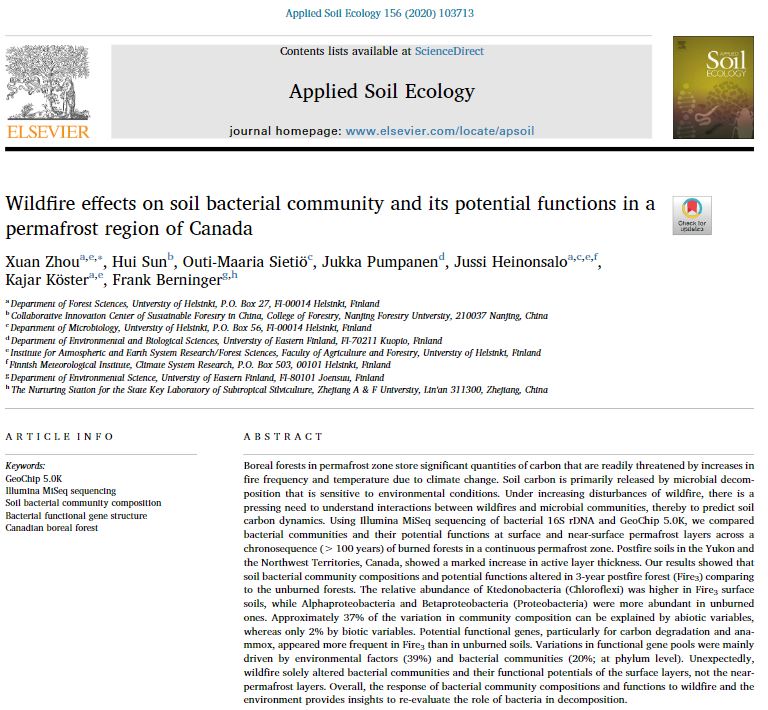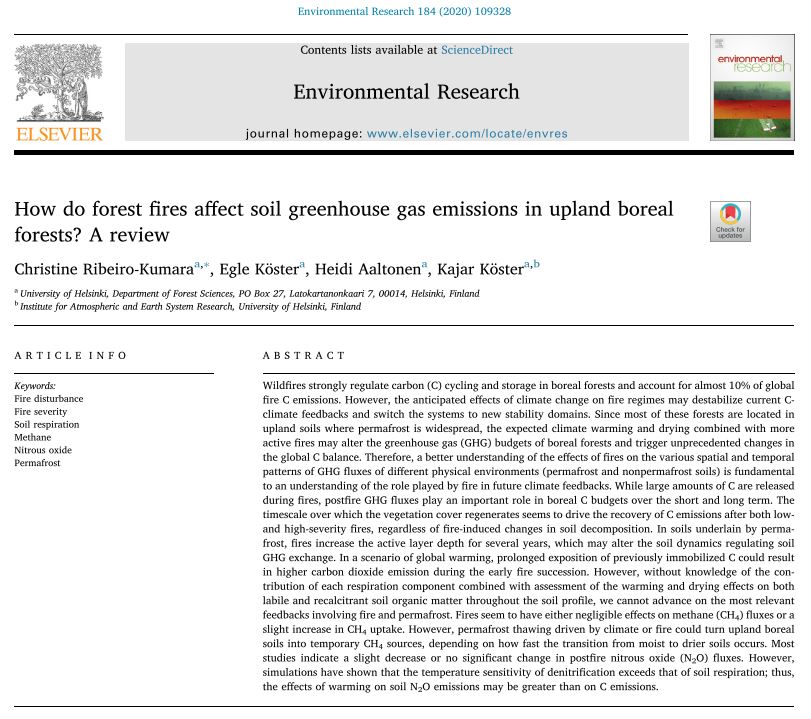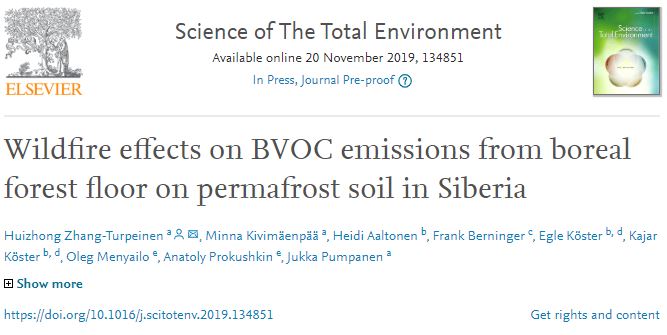Disturbances and Biogeochemistry Team would like to inform you all, that we have now new blog location!
As, all the key persons of the team are working now in University of Eastern Finland, we needed to move our web/blog page.
you can find us from
Disturbances and Biogeochemistry Team would like to inform you all, that we have now new blog location!
As, all the key persons of the team are working now in University of Eastern Finland, we needed to move our web/blog page.
you can find us from

New paper by Köster et al., (Biochar Seedling project) shows the effect of biochar amendment on the properties of growing media and growth of containerized Norway spruce, Scots pine, and silver birch seedlings.
The main purpose of the study was to develop and test novel substrates in which to grow forest tree seedlings in nurseries. We studied the impact of added wood biochar on the properties of the growing media and on the growth of Scots pine, Norway spruce, and silver birch seedlings. Specifically, we aimed to test and estimate the optimal amount of biochar to be added to the growing media to obtain the maximal growth of tree seedlings. Additionally, subtreatments of fertilization were done to test the interaction of biochar amendment and fertilization (biochar x fertilization).
We found that biochar amendment slightly reduced the soil water retention of the growing media due to the high water-holding capacity of raw peat. Due to its alkaline character, biochar had a significantliming effect and could replace other liming components in the growing media. In addition, biochar amendment had a significant effect on the nutrient concentration of the growing media,as it significantly increased the concentrations of all analysed nutrients (C, N, P, and K). Biochar affected the aboveground growth of spruce and pine seedlings and increased the root dry mass and diameter of birch seedlings. Fertilization improved the quality of seedlings, measured by DQI. We also observed no variation in DQI values for 50% and 100% fertilized seedlings, which suggests that the use of fertilizers could be reduced with biochar amendment. Adding up to 20% biochar for spruce, pine, and birch did not reduce overall seedling performance when fertilization was used. We can conclude that biochar could be used as a peat additive in the nursery production of tree seedlings. The results suggest that the growing media could be amended with 20% biochar for spruce and 10% biochar for pine and birch seedlings.

New review paper by Zhou et al., 2020 indicated that wildfire significantly reshaped bacterial community composition and its potential functions in the surface soil layer, but did not shift those in the deep soil layer. The differences in bacterial community composition and its functional potentials between burned and unburned forests were primarily determined by abiotic variables such as the soil temperature, moisture and available soil nutrients. Overall, the study highlights bacterial fitness over a fire-induced environmental gradient in a continuous permafrost region, improving our understanding of temporal shifts in bacterial community compositions and their abilities to control post-fire C and N cycles.
The aim of the experimental burning is to test the effect of different fire intensities on GHG and BVOC emissions from the soil, on soil organic matter quantity and quality, on microbial biomass and composition, on pyrogenic carbon (char) creation, etc. Also to test different measuring equipment (temperature sensors, low cost CH4 sensors, etc.).
The experiment is planned in collaboration with Häme University of Applied Sciences (HAMK), Institute for Atmospheric and Earth System Research/Forest Sciences (Disturbance and biogeochemistry team) in University of Helsinki, University of Eastern Finland (Department of Environmental Science, Kuopio and Joensuu), LUKE (Jokioinen), Emergency Services Academy Finland (Pelastusopisto).


Heidi Aaltonen was defending the doctoral dissertation entitled “Carbon dynamics in forest fire affected permafrost soils” in the Faculty of Agriculture and Forestry on 11 June 2020.
CONCRATULATIONS HEIDI, JOB WELL DONE!

On 07.04.2020 the Faculty of Agriculture and Forestry Council (University of Helsinki) decided to propose the title of docent to Ph.D. Kajar Köster (forest disturbance ecology)

New review paper by Ribeiro-Kumara et al., 2020 focuses on four different standpoints to explore the effects of fire on greenhouse gas (GHG) fluxes in boreal forests: fire severity, time after fire, physical environment, and temperature sensitivity (Q10). High-severity fires have stronger effects on soil CO2 efflux than low-severity fire. Soil CO2 efflux generally increases as a function of time after fire, with the re-establishment of vegetation cover governing the recovery of soil CO2 emissions. Fire effects on soil CO2 emissions in permafrost areas are tightly linked to fire-induced changes in SOM throughout the soil profile. The fire-severity effects on CH4 and N2O fluxes are still uncertain, since very few studies have been conducted after low-severity fires. Upland boreal forests in permafrost and nonpermafrost areas seem to act as CH4 sinks during the fire succession, although a strong trend has not yet been identified. The fire effects on CH4 fluxes may be associated with soil moisture and diffusivity conditions at the time of fire and active layer depth after fire. The direction of the N2O fluxes across a fire succession is still uncertain, while soil temperature is the most studied driver for N2O emissions.

New paper by Ide et al., 2020 investigates how forest fires can change the quality of dissolved organic matter (DOM) in soils, and consequently have an influence on biogeochemical cycles in forest ecosystems. To clarify the effects of fire on the chemical composition of DOM in boreal forest soils, the molecular composition of soil DOM was compared between recently-burned and long-unburned boreal forests (6 and 156 years since the last fire, respectively) in Finnish Lapland.
Ultrahigh-resolution Fourier transform ion cyclotron resonance mass spectrometry revealed that there were no significant differences in species, average molecular weight or the number of molecular compounds detected between the recently-burned and long-unburned forests. However, the number of compounds with condensed aromatic structures tended to be larger in the recently-burned forest, whereas the numbers of proteins and carbohydrates not shared between the two forests were significantly smaller. The study suggests that fire not only generated several species of dissolved black carbon, but also caused burned plant residues, which supplied diverse lignin-like molecules in the recently-burned forest soils and led to the number of molecular species being comparable to that in the long-unburned forest soils.
New attempt! Book the dates!
We are currently planning a prescribed fire (burning experiment) close to Evo, Finland.


This will be the test burning, to prepare for the bigger campaign in summer of 2021. Currently the plan is to establish experimental burning areas in 70-80 year old Scots pine stands (sandy soils), and the burning should take place between 15.05 – 15.06.2020.

We are aiming surface fires with two different intensities – two different treatments with burning temperatures around 300 degrees and 600 degrees (acheaved by biomass treatment).

The aim of the experimental burning is to test the effect of different fire intensities on GHG and BVOC emissions from the soil, on soil organic matter quantity and quality, on microbial biomass and composition, on pyrogenic carbon (char) creation, etc. Also to test different measuring equipment (temperature sensors, low cost CH4 sensors, etc.).

The experiment is planned in collaboration with Häme University of Applied Sciences (HAMK), Institute for Atmospheric and Earth System Research/Forest Sciences (Disturbance and biogeochemistry team) in University of Helsinki, University of Eastern Finland (Department of Environmental Science, Kuopio and Joensuu), LUKE (Jokioinen), Emergency Services Academy Finland (Pelastusopisto).

New paper by Zhang-Turpinen et al. studied the long-term effects of wildfire on forest floor BVOC emission rates along a wildfire chronosequence in a Larix gmelinii forest in central Siberia – how forest wildfires and the subsequent succession of ground vegetation, as well as changes in the availability of SOM along with the deepened and recovered active layer, influence BVOC emission rates.
The results showed that forest floor acted as source of a large number of BVOCs in all forest age classes. Monoterpenes were the most abundant BVOC group in all age classes. The total BVOC emission rates measured from the 23- and >100-year-old areas were ca. 2.6 times higher than the emissions from the 1-year-old area. Lower emissions were related to a decrease in plant coverage and microbial decomposition of SOM after wildfire. The results also showed that forest wildfires play an important indirect role in regulating the amount and composition of BVOC emissions from post-fire originated boreal forest floor. This could have a substantial effect on BVOC emissions if the frequency of forest wildfires increases in the future as a result of climate warming.